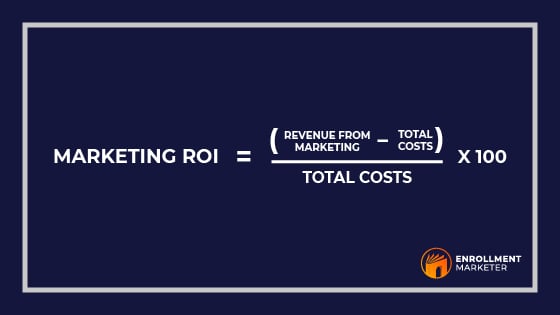How to Calculate the ROI of Enrollment Marketing Campaigns
It’s only natural for an enrollment marketing professional to want to show the return-on-investment (ROI) that their marketing efforts have produced. ROI makes it very easy for someone to demonstrate the value that their department, and their unique role, has played in working toward the institution’s goals. This post will answer:
- What is ROI?
- Challenges of calculating higher ed ROI
- How to calculate the ROI of enrollment marketing campaigns
What is ROI?
ROI is a formula that shows the financial results of your marketing efforts. In a nutshell, the formula expresses mathematically how much profit your marketing endeavors are producing. In order to calculate ROI for a given campaign, you need to know how much money you are spending on marketing for that campaign and how much revenue the campaign is generating. In theory this sounds easy enough, but the reality of the situation is much more complicated and can involve a lot of guesswork and estimation.
ROI Formula
ROI is generally calculated by taking the total profits created by your marketing efforts and dividing that by the cost of your efforts, then multiplying it by 100. If your efforts were successful, this would result in a positive number. If the number is negative, then it means you spent more on your marketing efforts than you brought back in.

Challenges of Calculating Higher Ed ROI
If you attended a college or university, think back to how you decided which school to attend.
You might have heard about the school from a friend and decided to investigate. Perhaps the school you chose was the one that provided you with the most financial aid. Maybe you live in the same area as the college and wanted to be able to live at home while attending college to cut down on the cost of attendance, or maybe you just wanted to attend a college that aligned with your personal values.
There are so many factors that go into college planning that it can be difficult to trace each of the touchpoints that ultimately lead a student to matriculation. This poses a challenge if you are trying to calculate the ROI of an awareness or content marketing campaign.
Other challenges can arise from lack of organization. Data can often get jumbled or entered incorrectly. Miscommunication between departments such as admissions and marketing can make connecting campaigns to matriculations difficult. One way you can work to ensure that you remain organized is to build a communications calendar to help your team collaborate effectively.
As nice as it would be to be able to simply plug a few numbers into the ROI formula, the reality is that the process is much more complicated than a simple mathematical formula. For example, consider the prospect of computing the marketing ROI of a campaign if your goal is to increase word-of-mouth advertising. As it is nearly impossible to track word-of-mouth marketing, it can be immensely difficult to generate a mathematical estimation of the ROI of a word-of-mouth campaign. However, this does not mean that there is no room for ROI in such campaigns, it just means that you may have to get a bit creative.
1. Set goals.
It is always important to begin by setting clear goals. What metric or metrics are you trying to move with your marketing efforts? Are you trying to increase the number of applications to the school as a whole, or to specific programs? Are you trying to increase the actual number of deposited/matriculated students? Are you trying to increase the number of donations, or the amount of funds raised from alumni? It’s important to know your goals before you begin trying to calculate the success of your endeavors.
2. Establish a means of tracking success.
Next, you will need a way to track your progress toward your goals. Typically, you’ll do this by setting a baseline for where you currently stand, and then track your performance over time. Without proper tracking, you’ll never know whether or not your campaigns are successful.
For many campaigns, your primary goal will be to increase inquiries (leads) for a given program or a portfolio of programs. Inbound marketing platforms like HubSpot make this easy,
For some campaigns, such as word-of-mouth advertising, it can be challenging if not impossible to track the results of your campaign. However, here are some ways that you can try and track your progress:
- Social listening: If you are trying to generate buzz around your school and get people talking, stay updated on what people are saying on social media
- Survey your students: Ask your students how they first discovered your school. Did they see an ad for your school on social media, or did a family member attend?
- Survey your leads: Ask your leads how they found out about your school or program. Try to find out if increases in the number of leads who heard about your school through word-of-mouth corresponds to word-of-mouth marketing efforts.
One important thing to remember is to stay as organized as possible. Tracking your progress can be an arduous task at best, and it can be easy to become overwhelmed.
3. Assign a dollar amount to your efforts.
Once you know the metrics you are trying to move, you can assign a dollar amount to those metrics. For example, you know that each matriculated student will bring in a certain amount of profit through tuition. Therefore, if you are working to increase student matriculations, you would calculate the value of your efforts as the cost of tuition x the number of matriculated students tied to your efforts.
Applications, on the other hand, are a bit trickier, because not every application will lead to matriculation. To determine the value of each application, you would need to calculate your application-to-matriculation conversion rate. This can be calculated by dividing the number of matriculated students by the number of applications and multiplying it by 100. This will let you estimate how many actual matriculations your applications will lead to, which can help you assign a value per application.
Awareness campaigns can be difficult to assign a tangible value to, because you may not know whether your awareness campaign resulted in direct conversions. You may have to make an educated guess of the value of your campaign. You can base this guess on:
- How many leads your campaign generated: How many landing page visitors turned into leads? How many people signed up for your newsletter? Use this information to determine your visitor-to-lead conversion rate. You can calculate this by dividing the number of leads generated by the number of individuals your awareness campaign reaches.
- How many leads matriculate: Of the leads you generated, how many enrolled in your program? Your lead-to-matriculation conversion rate can be calculated by dividing the number of your leads who became matriculated students by the total number of leads generated.
- Your student lifetime value: Your student lifetime value (SLV) is the average revenue that a single student brings to your school. This metric can be calculated by multiplying your student value by the average number of years your student remains enrolled in your program. For example, if your student brings your school tuition revenue of $15,000 per year and remains enrolled at your school for four years, your SLV will be $60,000, or $15,000 x 4.
- Put it all together: Finally, multiply your SLV by your lead-to-conversion rate, and multiply the answer by the visitor-to-lead conversion rate. This will give you the average value of each person your awareness campaign reaches. You can use this number to estimate the revenue your marketing efforts generate and input the numbers into your ROI calculation.
This may seem convoluted and confusing, but keep in mind that not every campaign is going to provide you with clear-cut metrics that you can easily insert into a formula. However, this does not mean that the campaign is not beneficial to your school. Assigning a dollar value to your efforts based on guesswork and estimation may not result in a ROI calculation that is 100% accurate, but it can still provide valuable insight into the results of your campaigns. As you work through the process of assigning a dollar amount to your efforts, keep your goals at the forefront of your mind.
4. Track the costs of your marketing efforts.
Make sure that you keep track of how much your marketing efforts cost. Not only is this important in making sure you don’t go over budget, but it also is a key component of calculating your ROI. This should include costs like:
- Marketing tools: Specific software subscriptions that you purchased/used for the campaign. Marketing software, email software
- Labor costs: Your salary (or the percentage of your salary dedicated to the campaign), salary of other team members, cost of contractors or consultants
- Material costs: If you’re producing physical marketing materials like flyers, brochures, signs, etc.
- Advertising spend: If supporting the campaign with ads (radio, television, print, social media, etc.)
Once you have all of these pieces in place, all you need to do is run the calculation. Remember that the formula is:
([Revenue from marketing - total costs of marketing]/total costs of marketing) x 100
Once you have calculated your ROI, you can use it to determine whether your marketing campaign was a financial success or whether it would be better to allocate your budget to other more successful campaigns.
Next Steps
Ultimately, knowing how to calculate ROI is pretty useless if you don’t have a marketing strategy in place to begin with.
Take a look at this guide to building an inbound marketing plan for your higher ed institution. It is also important to stay up to date on the latest enrollment marketing practices and trends. Subscribe to the Enrollment Marketer newsletter to receive helpful articles and resources right in your inbox that will help you learn about and stay on top of the world of enrollment management and marketing.



